Identification and Geographic Distribution of Accommodation and Catering Centers
Abstract
:1. Introduction
2. Literature Review and Theoretical Framework
2.1. Literature Review
2.1.1. Location Selection and Agglomeration Effect
2.1.2. Geographic Distribution and Identification Methods
2.2. Theoretical Framework
3. Materials and Methods
3.1. Overview of the Study Area
3.2. Data Source
3.3. Method
3.3.1. Identification of a Cluster Center
3.3.2. Location Quotient
4. Results
4.1. Spatial Distribution of the Accommodation and Catering Industry
4.1.1. Distribution Density
4.1.2. Spatial Structure
4.1.3. Cluster Center
4.2. Uncertainty and Sensitivity Analysis
4.3. The Functional Difference of Cluster Centers
5. Discussion
6. Conclusions
Author Contributions
Funding
Acknowledgments
Conflicts of Interest
Appendix A
| No. | Leisure Dining | Commercial Accommodation | Fast Food | Restaurant |
|---|---|---|---|---|
| #1 | 0.39 | 1.10 | 0.84 | 1.27 |
| #2 | 0.64 | 0.92 | 0.84 | 1.23 |
| #3 | 1.36 | 0.53 | 1.06 | 0.96 |
| #4 | 1.33 | 1.06 | 1.07 | 0.83 |
| #5 | 1.62 | 0.55 | 1.00 | 0.90 |
| #6 | 0.44 | 0.89 | 1.00 | 1.22 |
| #7 | 0.51 | 1.20 | 1.30 | 0.95 |
| #8 | 0.64 | 1.30 | 0.94 | 1.08 |
| #9 | 0.49 | 0.72 | 1.30 | 1.08 |
| #10 | 0.44 | 1.79 | 1.01 | 0.98 |
| #11 | 0.65 | 0.82 | 1.38 | 0.95 |
| #12 | 0.75 | 0.67 | 0.98 | 1.18 |
| #13 | 0.55 | 1.04 | 1.25 | 1.01 |
| #14 | 0.61 | 1.02 | 1.00 | 1.13 |
| #15 | 0.24 | 1.61 | 1.06 | 1.07 |
| #16 | 0.91 | 0.83 | 1.03 | 1.05 |
| #17 | 0.38 | 1.40 | 1.01 | 1.10 |
| #18 | 0.22 | 1.83 | 1.13 | 0.98 |
| #19 | 0.53 | 1.05 | 0.92 | 1.19 |
| #20 | 0.81 | 1.73 | 1.19 | 0.77 |
| #21 | 0.10 | 1.87 | 1.18 | 0.98 |
| #22 | 1.21 | 0.38 | 1.15 | 1.00 |
| #23 | 2.38 | 0.74 | 0.56 | 0.84 |
| #24 | 0.60 | 1.14 | 1.08 | 1.05 |
| #25 | 1.16 | 1.67 | 0.76 | 0.91 |
| #26 | 1.38 | 0.92 | 0.97 | 0.91 |
| #27 | 0.28 | 1.60 | 1.12 | 1.03 |
| #28 | 0.19 | 0.82 | 1.12 | 1.25 |
| #29 | 0.77 | 1.25 | 0.85 | 1.10 |
| #30 | 0.79 | 0.63 | 0.55 | 1.42 |
| Mean | 0.75 | 1.10 | 1.02 | 1.05 |
| Max | 2.38 | 1.87 | 1.38 | 1.42 |
| Min | 0.10 | 0.38 | 0.55 | 0.77 |
References
- Đorđević, D.Ž.; Janković, M. Modern distribution and development of hotel industry in the world. Ekonomika 2015, 61, 99–110. [Google Scholar]
- Bull, P.J.; Church, A. The Hotel and Catering Industry of Great Britain during the 1980s: Sub-Regional Employment Change, Specialization and Dominance; John Wiley & Sons Ltd.: Chichester, UK, 1994; pp. 248–269. [Google Scholar]
- Bégin, S. The geography of a tourist business: Hotel distribution and urban development in Xiamen, China. Tour. Geogr. 2000, 2, 448–471. [Google Scholar] [CrossRef]
- Wood, R.C. Hospitality industry labour trends. Tour. Manag. 1992, 13, 297–304. [Google Scholar] [CrossRef]
- Yang, Z.; Sliuzas, R.; Cai, J.; Ottens, H.F.L. Exploring spatial evolution of economic clusters: A case study of Beijing. Int. J. Appl. Earth Obs. Geoinf. 2012, 19, 252–265. [Google Scholar] [CrossRef]
- James, P.; Bound, D. Urban morphology types and open space distribution in urban core areas. Urban Ecosyst. 2009, 12, 417. [Google Scholar] [CrossRef]
- Assaf, A.G.; Agbola, F.W. Total Productivity in the Australian Hotel Industry: Estimating and Bootstrapping Malmquist Indices. Tour. Anal. 2011, 16, 295–304. [Google Scholar] [CrossRef] [Green Version]
- Luo, H.; Yang, Y. Spatial pattern of hotel distribution in China. Tour. Hosp. Res. 2013, 13, 3–15. [Google Scholar] [CrossRef]
- Glaeser, E.L.; Kahn, M.E. Sprawl and urban growth. In Handbook of Regional and Urban Economics; Elsevier: Amsterdam, The Netherlands, 2004; Volume 4, pp. 2481–2527. [Google Scholar]
- Rienow, A.; Stenger, D.; Menz, G. Sprawling cities and shrinking regions—Forecasting urban growth in the Ruhr for 2025 by coupling cells and agents. Erdkunde 2014, 68, 85–107. [Google Scholar] [CrossRef]
- Li, J.; Sun, D. Industrial Composition and Agglomeration Shadow: Evidence from China’s Large Urban Systems. Complexity 2020, 2020, 5717803. [Google Scholar]
- Li, R.; Guo, Q.; Wu, D.; Yin, H.; Zhang, H.; Zhu, T. Spatial characteristics of development efficiency for urban tourism in eastern China: A case study of six coastal urban agglomerations. J. Geogr. Sci. 2014, 24, 1175–1197. [Google Scholar] [CrossRef]
- Dassah, E. An Examination of the Relationship between Spatial Morphology and Residential Satisfaction in Residential Settings in Garki, Abuja. Master’s Thesis, Edith Cowan University, Perth, WA, Australia, 2011. [Google Scholar]
- Liu, Z.; Liu, S. Polycentric development and the role of urban polycentric planning in China’s mega cities: An examination of Beijing’s metropolitan area. Sustainability 2018, 10, 1588. [Google Scholar] [CrossRef] [Green Version]
- Maskell, P.; Lorenzen, M. The cluster as market organisation. Urban Stud. 2004, 41, 991–1009. [Google Scholar] [CrossRef]
- Bhat, P.A.; ul Shafiq, M.; Mir, A.A.; Ahmed, P. Urban sprawl and its impact on landuse/land cover dynamics of Dehradun City, India. Int. J. Sustain. Built Environ. 2017, 6, 513–521. [Google Scholar] [CrossRef]
- Feng, J.; Zhou, Y.; Wu, F. New trends of suburbanization in Beijing since 1990: From government-led to market-oriented. Reg. Stud. 2008, 42, 83–99. [Google Scholar] [CrossRef] [Green Version]
- Weltevreden, J.W.J.; van Rietbergen, T. The implications of e-shopping for in-store shopping at various shopping locations in the Netherlands. Environ. Plan. B Plan. Des. 2009, 36, 279–299. [Google Scholar] [CrossRef]
- Rebelo, C.; Rodrigues, A.M.; Tenedório, J.A. Dasymetric Mapping Using UAV High Resolution 3D Data within Urban Areas. Remote Sens.-Basel 2019, 11, 1716. [Google Scholar] [CrossRef] [Green Version]
- Lan, T.; Yu, M.; Xu, Z.; Wu, Y. Temporal and spatial variation characteristics of catering facilities based on POI data: A case study within 5th Ring Road in Beijing. Procedia Comput. Sci. 2018, 131, 1260–1268. [Google Scholar] [CrossRef]
- Zhang, X.; Li, W.; Zhang, F.; Liu, R.; Du, Z. Identifying urban functional zones using public bicycle rental records and point-of-interest data. ISPRS Int. J. Geo-Inf. 2018, 7, 459. [Google Scholar] [CrossRef] [Green Version]
- Shen, Z.; Li, M. Big Data Support of Urban Planning and Management: The Experience in China; Springer: Berlin/Heidelberg, Germany, 2017. [Google Scholar]
- Blair, J.P.; Premus, R. Major factors in industrial location: A review. Econ. Dev. Q. 1987, 1, 72–85. [Google Scholar] [CrossRef]
- Weber, A. Theory of the Location of Industries; University of Chicago Press: Chicago, IL, USA, 1929. [Google Scholar]
- Losch, A. The Economics of Location; Yale University Press: New Haven, CT, USA, 1955. [Google Scholar]
- Ellison, G.; Glaeser, E.L.; Kerr, W.R. What causes industry agglomeration? Evidence from coagglomeration patterns. Am. Econ. Rev. 2010, 100, 1195–1213. [Google Scholar] [CrossRef] [Green Version]
- Alcácer, J.; Chung, W. Location strategies for agglomeration economies. Strateg. Manag. J. 2014, 35, 1749–1761. [Google Scholar] [CrossRef] [Green Version]
- Marshall, A. Principles of Economics: Unabridged Eighth Edition; Cosimo, Inc.: New York, NY, USA, 2009. [Google Scholar]
- Glatte, T.; Haupt, T. Location strategies: Methods and their methodological limitations. J. Eng. Des. Technol. 2015, 13, 435–462. [Google Scholar] [CrossRef]
- Badr, K.; Rizk, R.; Zaki, C. Firm productivity and agglomeration economies: Evidence from Egyptian data. Appl. Econ. 2019, 51, 5528–5544. [Google Scholar] [CrossRef]
- Rodríguez-Clare, A. The division of labor and economic development. J. Dev. Econ. 1996, 49, 3–32. [Google Scholar] [CrossRef]
- Becker, R.A.; Henderson, J.V. Intra-Industry Specialization and Urban Development; Economics of Cities: Theoretical Perspectives; Cambridge University Press: Cambridge, UK, 2000; pp. 138–166. [Google Scholar]
- Bourdeau-Lepage, L.; Huriot, J.M. On poles and centers: Cities in the French style. Urban Public Econ. Rev. 2005, 3, 12–35. [Google Scholar]
- Krehl, A.; Siedentop, S. Towards a typology of urban centers and subcenters–evidence from German city regions. Urban Geogr. 2019, 40, 58–82. [Google Scholar] [CrossRef] [Green Version]
- Lin, D.; Allan, A.; Cui, J. Does Polycentric Urban Spatial Development Lead to Less Commuting: A Perspective of Jobs-Housing Balance. In Proceedings of the 49th ISOCARP Congress, Brisbane, QLD, Australia, 1–4 October 2013; p. 10. [Google Scholar]
- Huang, D.; Liu, Z.; Zhao, X. Monocentric or polycentric? The urban spatial structure of employment in Beijing. Sustainability 2015, 7, 11632–11656. [Google Scholar] [CrossRef] [Green Version]
- Cai, J.; Huang, B.; Song, Y. Using multi-source geospatial big data to identify the structure of polycentric cities. Remote Sens. Environ. 2017, 202, 210–221. [Google Scholar] [CrossRef]
- Ripley, B.D. Modelling Spatial Patterns. J. R. Stat. Soc. Ser. B 1977, 39, 172–212. [Google Scholar] [CrossRef]
- Bade, F.-J.; Bode, E.; Cutrini, E. Spatial fragmentation of industries by functions. Ann. Reg. Sci. 2015, 54, 215–250. [Google Scholar] [CrossRef]
- Marcon, E.; Puech, F. Measures of the geographic concentration of industries: Improving distance-based methods. J. Econ. Geogr. 2009, 10, 745–762. [Google Scholar] [CrossRef] [Green Version]
- Chen, Z.; Yu, B.; Song, W.; Liu, H.; Wu, Q.; Shi, K.; Wu, J. A new approach for detecting urban centers and their spatial structure with nighttime light remote sensing. IEEE T Geosci. Remote 2017, 55, 6305–6319. [Google Scholar] [CrossRef]
- Wu, Q.; Liu, H.; Wang, S.; Yu, B.; Beck, R.; Hinkel, K. A localized contour tree method for deriving geometric and topological properties of complex surface depressions based on high-resolution topographical data. Int. J. Geogr. Inf. Sci. 2015, 29, 2041–2060. [Google Scholar] [CrossRef]
- Gokan, T. On the Usage of the Measurements of Geographical Concentration and Specialization with Areal Data. Available online: https://www.semanticscholar.org/paper/On-the-usage-of-the-measurements-of-geographical-Gokan/136c3cbf7465c54110114cdbbdc177df15bebf77 (accessed on 24 August 2020).
- Aiginger, K.; Davies, S.W. Industrial specialisation and geographic concentration: Two sides of the same coin? Not for the European Union. J. Appl. Econ. 2004, 7, 231–248. [Google Scholar] [CrossRef] [Green Version]
- Rocha, J.; Tenedório, J.A. Spatial Analysis, Modelling and Planning; Intech Open: London, UK, 2018. [Google Scholar]
- Vermote, E.; Justice, C.; Claverie, M.; Franch, B. Preliminary analysis of the performance of the Landsat 8/OLI land surface reflectance product. Remote Sens. Environ. 2016, 185, 46–56. [Google Scholar] [CrossRef]
- Barlacchi, G.; Lepri, B.; Moschitti, A. Land Use Classification with Point of Interests and Structural Patterns. IEEE Trans. Knowl. Data Eng. 2020. [Google Scholar] [CrossRef]
- Deng, Y.; Liu, J.; Liu, Y.; Luo, A. Detecting urban polycentric structure from POI data. ISPRS Int. J. Geo-Inf. 2019, 8, 283. [Google Scholar] [CrossRef] [Green Version]
- Gong, L.; Jin, M.; Liu, Q.; Gong, Y.; Liu, Y. Identifying Urban Residents’ Activity Space at Multiple Geographic Scales Using Mobile Phone Data. ISPRS Int. J. Geo-Inf. 2020, 9, 241. [Google Scholar] [CrossRef]
- Qiao, C.F.; Chen, J.; Zhao, R.L.; Li, J. Preliminary studies on contour tree-based topographic data mining. In Proceedings of the International Symposium on Spatio-Temporal, Beijing, China, 27–29 August 2005. [Google Scholar]
- Okabe, A.; Satoh, T.; Sugihara, K. A kernel density estimation method for networks, its computational method and a GIS-based tool. Int. J. Geogr. Inf. Sci. 2009, 23, 7–32. [Google Scholar] [CrossRef]
- Liu, X.; Derudder, B.; Wu, K. Measuring polycentric urban development in China: An intercity transportation network perspective. Reg. Stud. 2016, 50, 1302–1315. [Google Scholar] [CrossRef]
- Zhan, D.S.; Meng, B. Spatial clustering analysis of residential and employment distribution in Beijing based on their social characteristics. Acta Geogr. Sin. 2013, 68, 1607–1618. [Google Scholar]
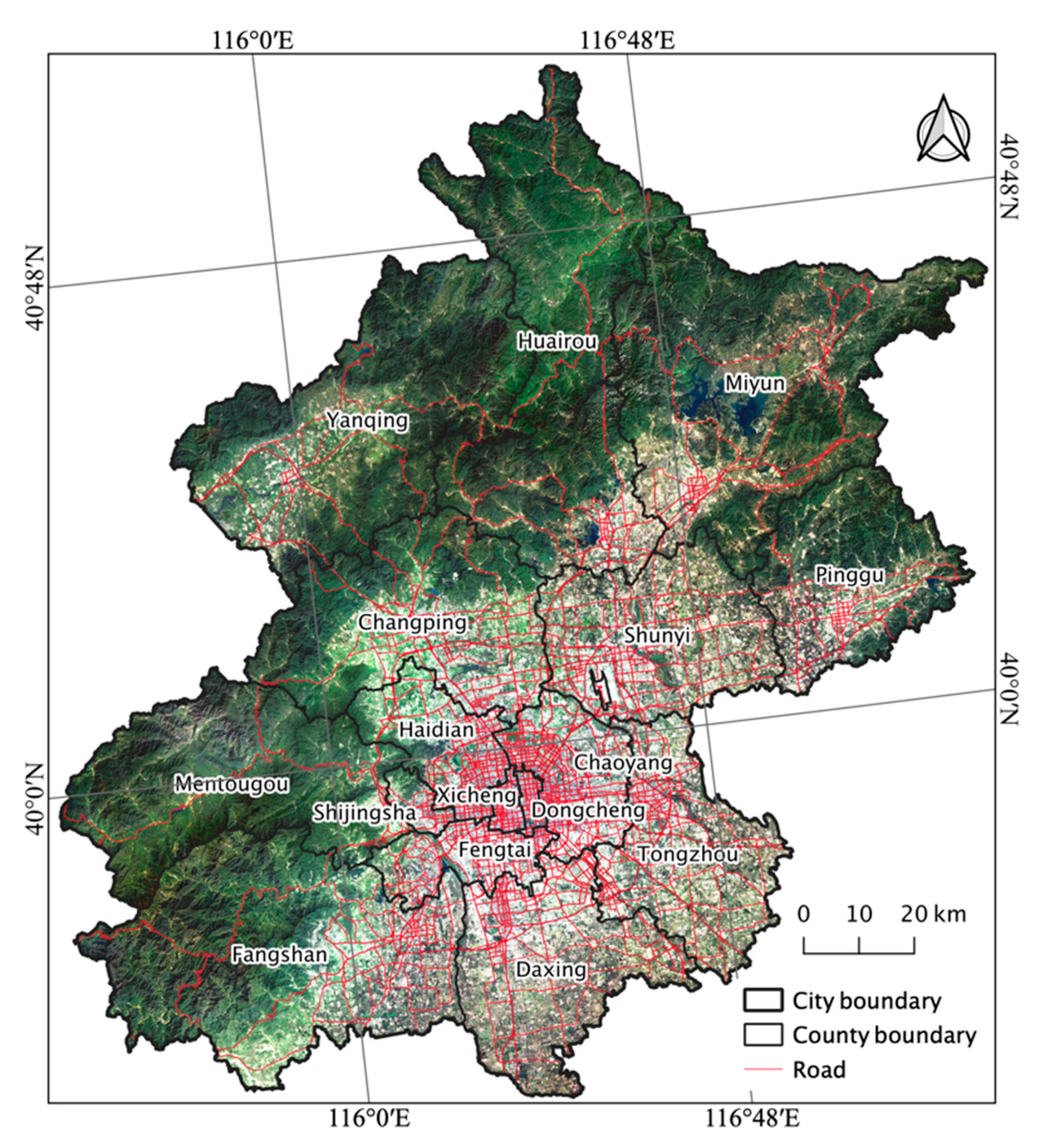
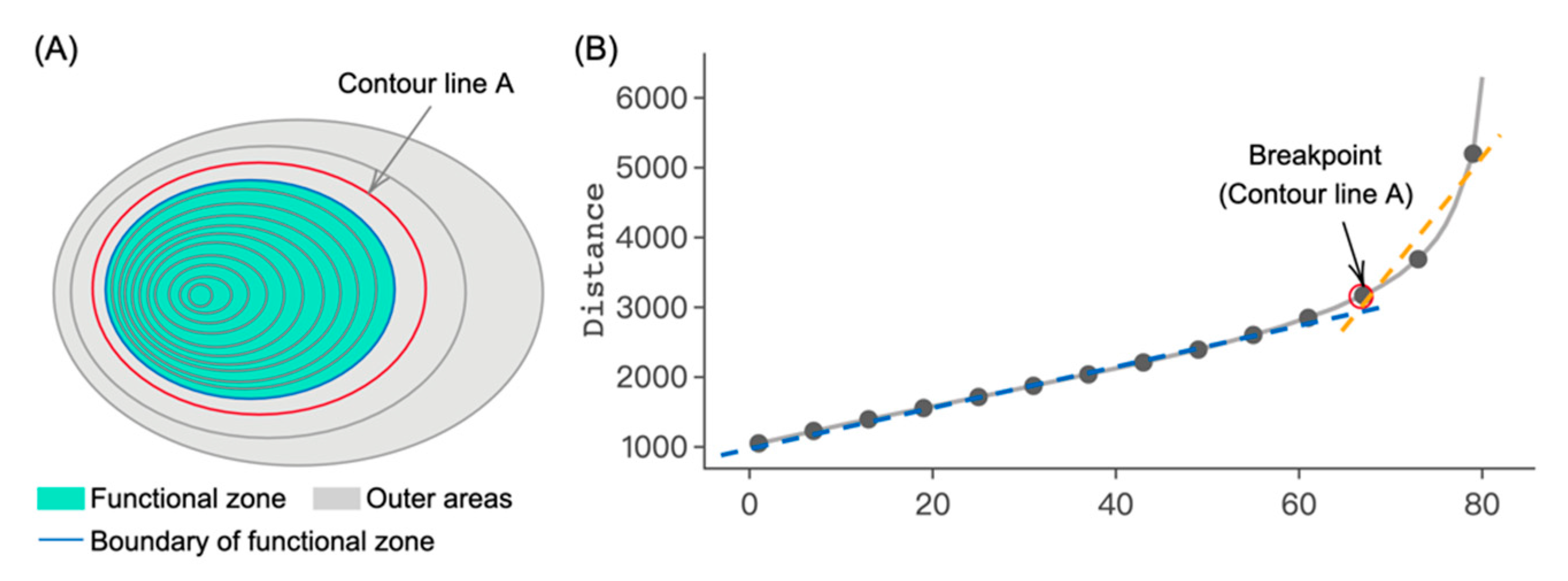

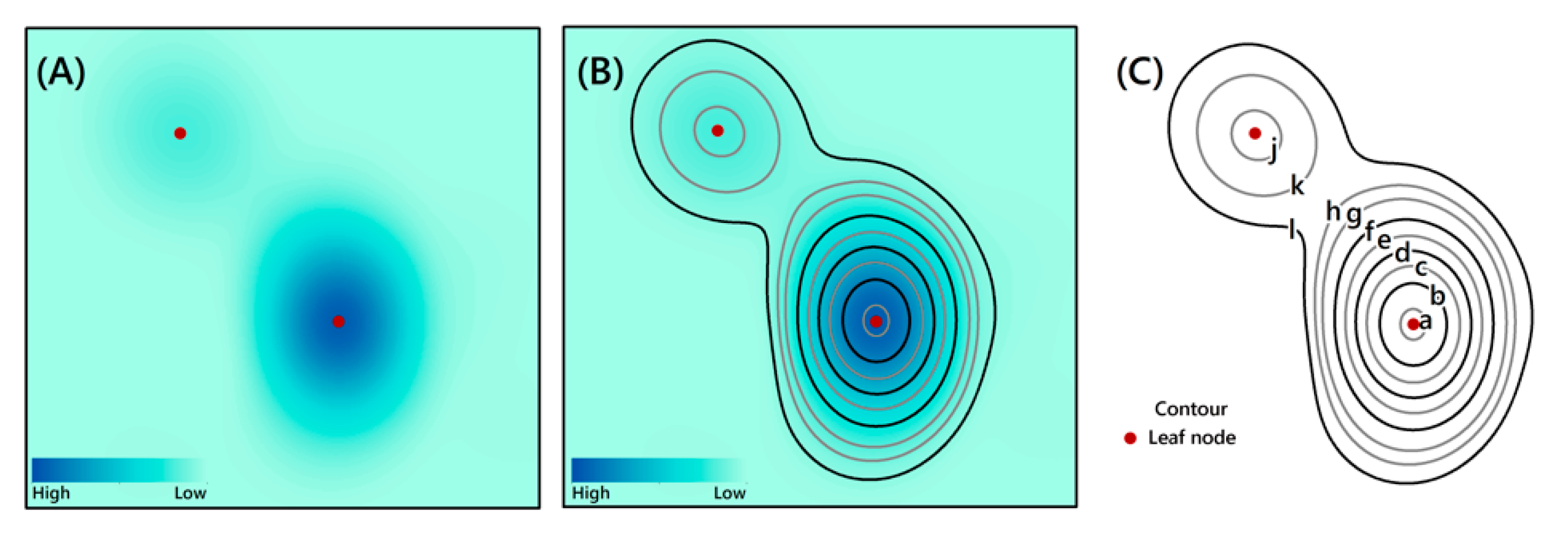
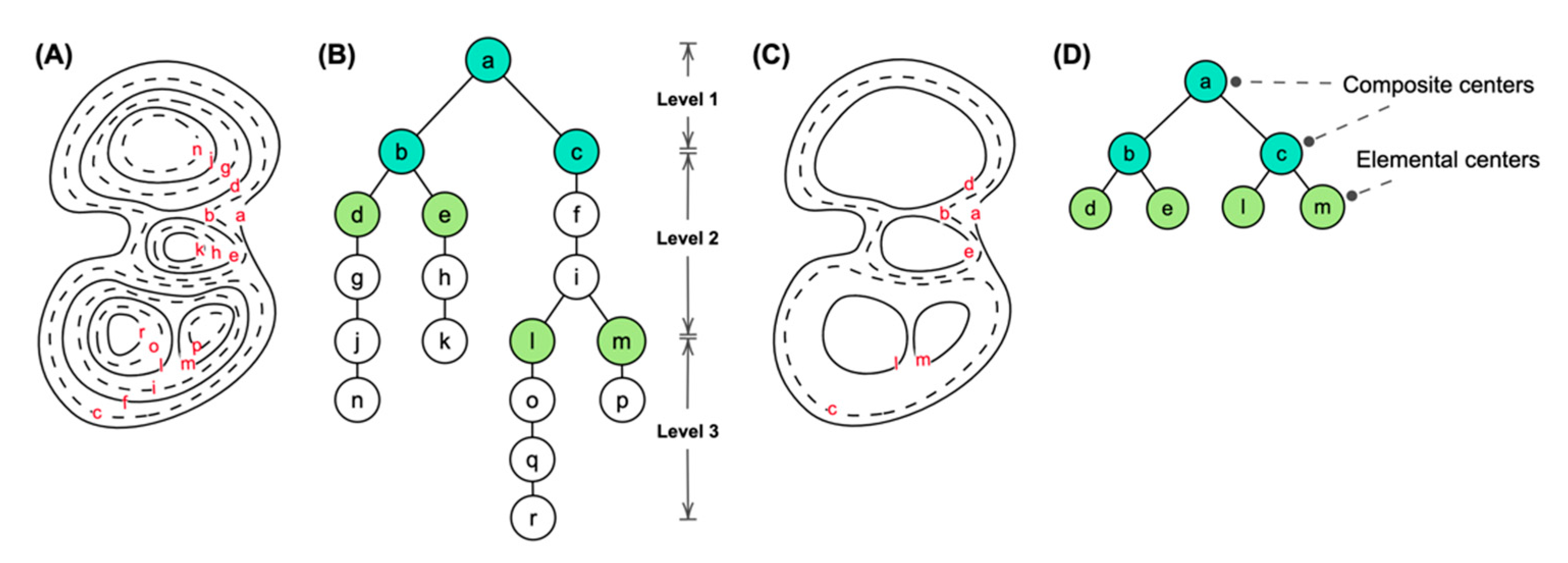


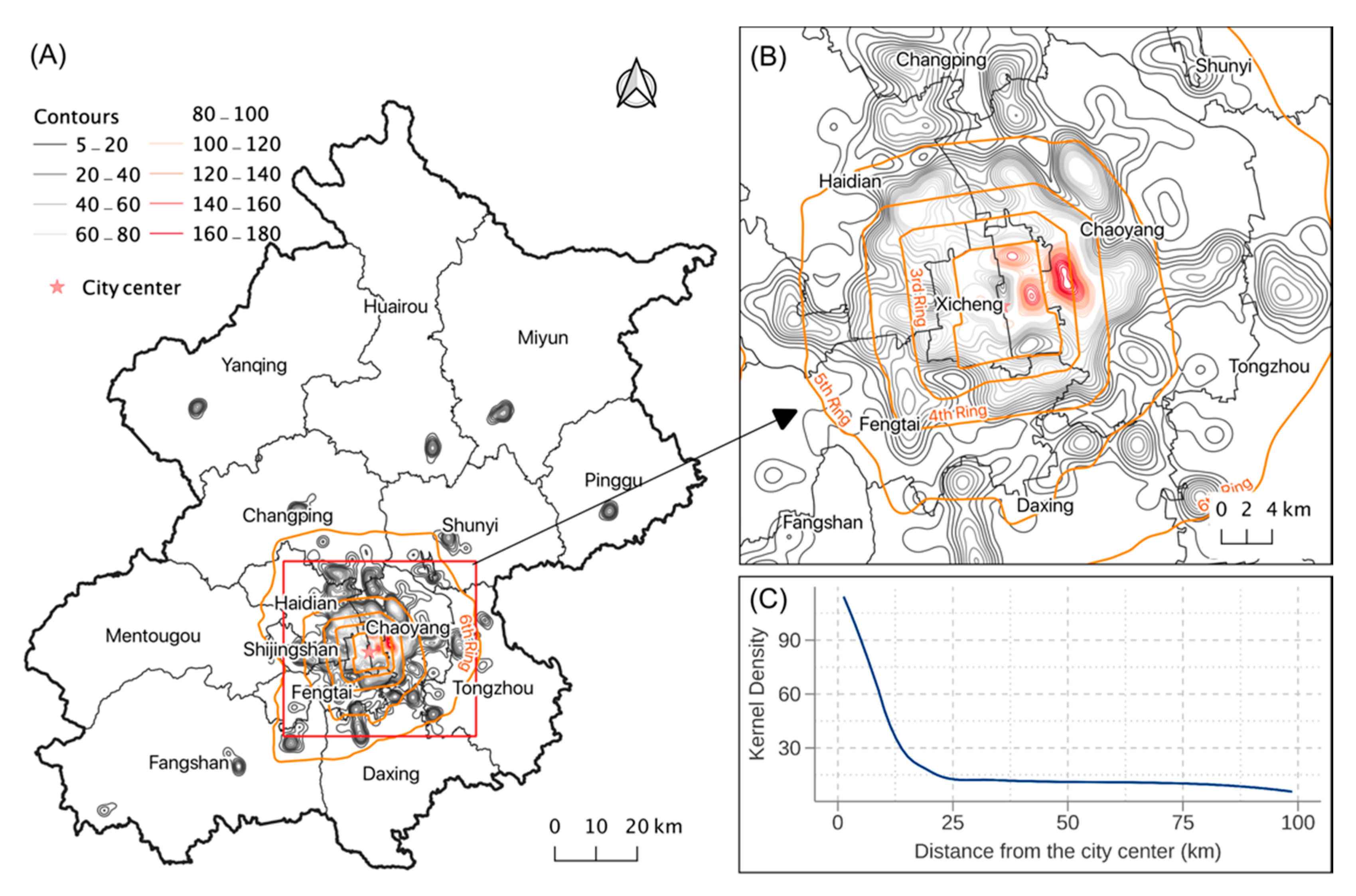
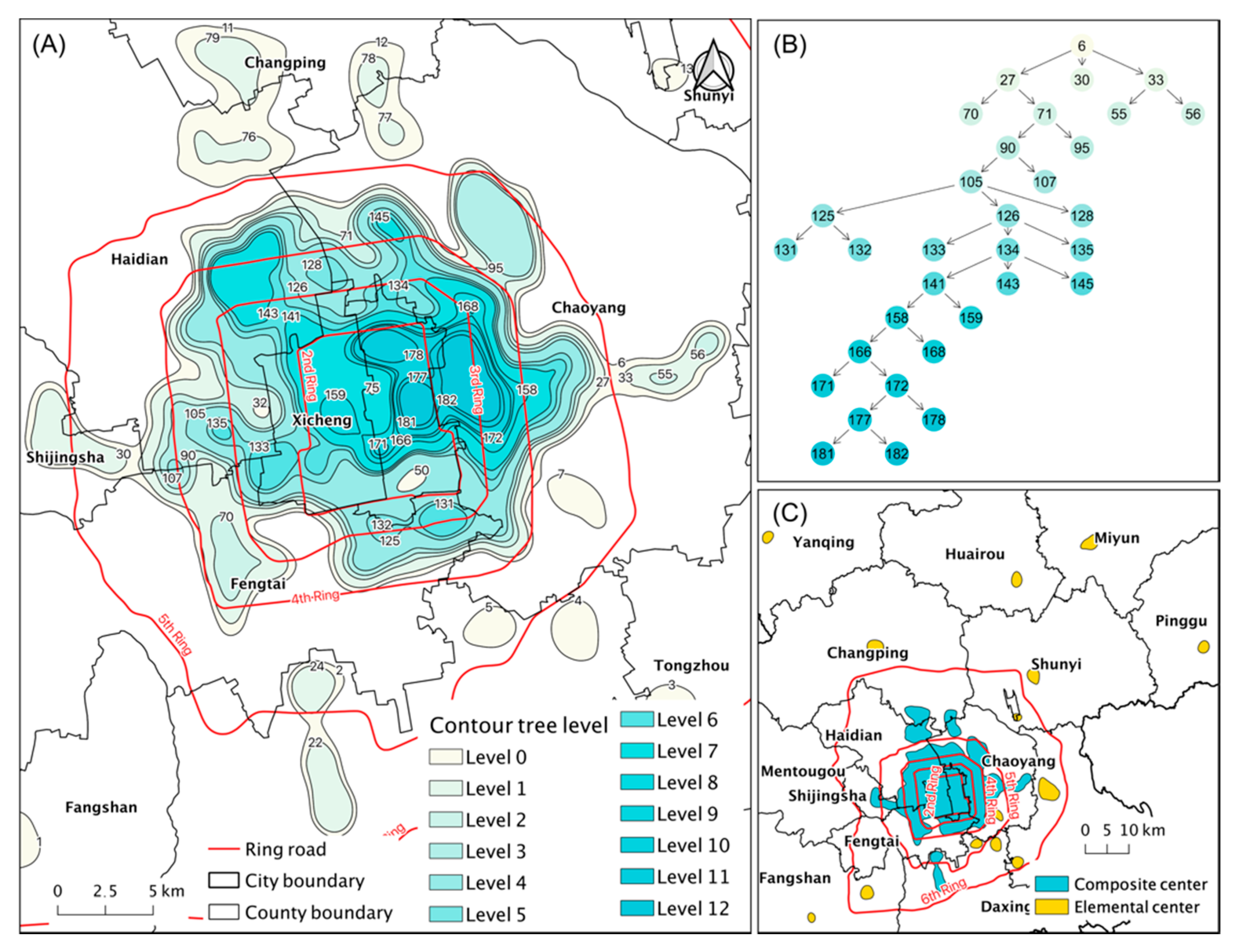



| Category | POI Subcategory | Quantity | Proportion (%) |
|---|---|---|---|
| Leisure catering | Teahouse, tea culture center, bar, cafe, cold drink shop | 4770 | 11.48 |
| Commercial accommodation | Hotel apartment, ordinary rental apartment, star hotel, general hotel | 6736 | 16.22 |
| Fast food | Fast food | 9187 | 22.12 |
| Restaurant | Local flavor restaurants, local famous restaurants, foreign flavor restaurants, and Chinese food restaurants | 20,843 | 50.18 |
| Administrative Region | No. | Location | POI Density | Geometric Properties | ||||
|---|---|---|---|---|---|---|---|---|
| Side Length (km) | Area (km2) | Width (km) | Height (km) | Height-Width Ratio | ||||
| Dongcheng District | #25 | Jianguomen Street, Chaoyangmen Street | 144.19 | 6.59 | 3.34 | 1.80 | 2.27 | 1.26 |
| #23 | Andingmen Street, Jiaodaokou Street, east of Beixinqiao Street | 132.85 | 7.17 | 3.58 | 2.90 | 1.68 | 0.58 | |
| Xicheng District | #29 | North of Deshengmen Street | 63.63 | 5.88 | 2.57 | 2.12 | 1.75 | 0.83 |
| #26 | East of West Chang’an Street and east of Financial Street | 98.89 | 6.53 | 3.00 | 2.04 | 2.04 | 1.00 | |
| #20 | Northeast of Guang’anmenwai Street, southwest of Yuetan Street | 71.77 | 7.83 | 4.59 | 2.52 | 2.46 | 0.97 | |
| Chaoyang District | #5 | Sanlitun Street, Chaowai Street, Hujialou Street, west side of Tuanjiehu Street, Jianwai Street | 155.05 | 12.11 | 9.74 | 3.23 | 4.46 | 1.38 |
| #30 | Capital international airport Street | 23.54 | 5.64 | 2.47 | 1.87 | 1.66 | 0.89 | |
| #3 | Northeast of Wangjing Street, Jiuxianqiao Street | 65.13 | 14.35 | 13.70 | 3.97 | 5.26 | 1.33 | |
| #29 | Southwest of Yayuncun Street, northwest of Anzhen Street | 63.63 | 5.88 | 2.57 | 2.12 | 1.75 | 0.83 | |
| #24 | Northwest of Laiguangying Street | 40.55 | 6.77 | 3.22 | 1.59 | 2.62 | 1.65 | |
| #15 | Southeast of Nanmofang Town, Fatou Street, northeast of Shibalidian Town | 23.47 | 8.97 | 5.23 | 3.01 | 2.79 | 0.93 | |
| Fengtai District | #27 | South of Fangzhuang Town, north of Dongtiejiangying Street | 71.27 | 6.44 | 3.10 | 2.46 | 1.70 | 0.69 |
| #20 | Northeast of Taipingqiao Street | 71.77 | 7.83 | 4.59 | 2.52 | 2.46 | 0.97 | |
| #10 | East of Fengtai Street, north of Xincun Street, south of Lugouqiao Street | 38.37 | 10.87 | 6.10 | 2.56 | 4.40 | 1.71 | |
| Shijingshan District | #2 | South side of Pingguoyuan Street, Bajiao Street, Laoshan Street, Lugu Street and north side of Babaoshan Street | 31.74 | 14.76 | 10.59 | 4.93 | 4.33 | 0.88 |
| Haidian District | #4 | Dongshengyuan, Zhongguancun Street, Haidian Street, Beixiaguan Street | 81.08 | 13.57 | 11.22 | 3.58 | 4.85 | 1.35 |
| #29 | East of Huayuan road Street, southwest of Yayuncun Street, northwest of Anzhen Street | 63.63 | 5.88 | 2.57 | 2.12 | 1.75 | 0.83 | |
| #20 | Southeast of Yangfangdian Street | 71.77 | 7.83 | 4.59 | 2.52 | 2.46 | 0.97 | |
| #11 | Qinghe Street, Shangdi Street, Xisanqi Street | 37.04 | 10.06 | 4.38 | 3.94 | 1.70 | 0.43 | |
| Fangshan District | #28 | Chengguan Street | 24.42 | 6.02 | 2.80 | 1.66 | 2.16 | 1.30 |
| #13 | Gongchen Street, east of Xilu Street | 29.73 | 9.50 | 7.06 | 2.96 | 3.02 | 1.02 | |
| Tongzhou District | #18 | Northwest of Majuqiao Town | 30.71 | 8.26 | 5.39 | 2.63 | 2.64 | 1.00 |
| #1 | Beiyuan Street, south side of Yongshun Town, west side of Zhongcang Street, Yuqiao Street, north of Liyuan Town | 29.67 | 15.61 | 17.10 | 4.76 | 5.16 | 1.09 | |
| Shunyi District | #30 | Northeast of Tianzhu Town | 23.54 | 5.64 | 2.47 | 1.87 | 1.66 | 0.89 |
| #12 | Shengli Street, Guangming Street, east of Wangquan Street | 30.97 | 9.96 | 7.42 | 2.74 | 3.56 | 1.30 | |
| Changping District | #9 | Huilongguan Street | 41.89 | 10.97 | 7.15 | 3.39 | 3.52 | 1.04 |
| #8 | Chengbei Street, northwest of Chengnan Street | 37.18 | 11.25 | 9.97 | 3.75 | 3.41 | 0.91 | |
| #24 | South of Tiantongyuan north Street and Tiantongyuan south Street | 40.55 | 6.77 | 3.22 | 1.59 | 2.62 | 1.65 | |
| Daxing District | #7 | East of Xingfeng Street and Qingyuan Street, west of Guanyinsi Street | 31.44 | 11.25 | 7.21 | 2.38 | 4.66 | 1.96 |
| #22 | Xihongmen Town | 31.00 | 7.22 | 4.03 | 2.22 | 2.45 | 1.11 | |
| #21 | Jiugong Town | 26.49 | 7.56 | 4.34 | 2.71 | 2.11 | 0.78 | |
| #16 | Beijing Economic-Technological Development Area | 28.41 | 8.83 | 5.98 | 2.42 | 3.10 | 1.28 | |
| Huairou District | #14 | Northeast of Longshan Street, Quanhe Street | 30.47 | 9.23 | 6.34 | 2.35 | 3.50 | 1.49 |
| Pinggu District | #17 | East of Binhe Street, north of Yuyang Town, south of Xinggu Street | 28.92 | 8.31 | 5.41 | 2.51 | 2.78 | 1.11 |
| Miyun District | #6 | Northeast of Guoyuan Street, Gulou Street | 30.75 | 11.70 | 9.41 | 3.97 | 3.41 | 0.86 |
| Yanqing District | #19 | Xiangshuiyuan Street, east of Rulin Street, northwest of Yanqing Town, north of Baiquan Street | 27.71 | 8.09 | 5.04 | 2.47 | 2.70 | 1.09 |
| In total | Average value | 51.27 | 9.38 | 6.38 | 2.85 | 3.07 | 1.11 | |
| Maximum value | 155.05 | 15.61 | 17.10 | 4.93 | 5.26 | 1.96 | ||
| Minimum value | 23.47 | 5.64 | 2.47 | 1.59 | 1.66 | 0.43 | ||
| Interval (Centers/km) | Number of Centers | Area of the Center (km2) |
|---|---|---|
| 2.5 | 41 | 290.86 |
| 5.0 | 30 | 191.45 |
| 7.5 | 28 | 192.66 |
| 10.0 | 29 | 169.88 |
© 2020 by the authors. Licensee MDPI, Basel, Switzerland. This article is an open access article distributed under the terms and conditions of the Creative Commons Attribution (CC BY) license (http://creativecommons.org/licenses/by/4.0/).
Share and Cite
Han, Z.; Song, W. Identification and Geographic Distribution of Accommodation and Catering Centers. ISPRS Int. J. Geo-Inf. 2020, 9, 546. https://0-doi-org.brum.beds.ac.uk/10.3390/ijgi9090546
Han Z, Song W. Identification and Geographic Distribution of Accommodation and Catering Centers. ISPRS International Journal of Geo-Information. 2020; 9(9):546. https://0-doi-org.brum.beds.ac.uk/10.3390/ijgi9090546
Chicago/Turabian StyleHan, Ze, and Wei Song. 2020. "Identification and Geographic Distribution of Accommodation and Catering Centers" ISPRS International Journal of Geo-Information 9, no. 9: 546. https://0-doi-org.brum.beds.ac.uk/10.3390/ijgi9090546





